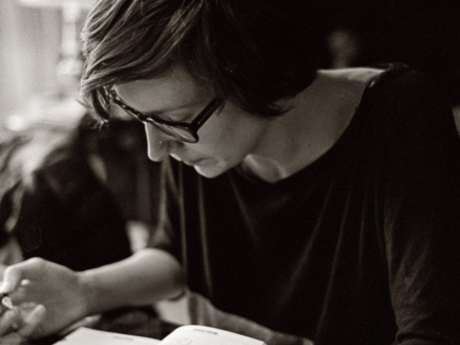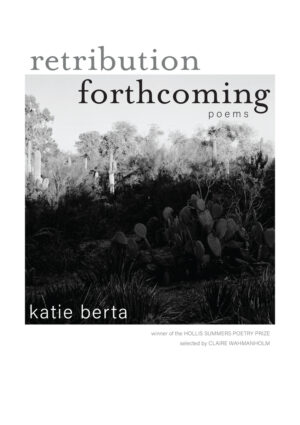In Their Own Words
Katie Berta on “How Is a River like a Woman the Poets Want to Know”

How Is a River like a Woman the Poets Want to Know
It is like a woman in that you can sail down it in a large skiff delivering goods
for manufacturing and resale.
Like a woman in that it contains layers and layers of animals, its own
ecosystem housing very very large fish and very very small fish.
Organisms like otters, turtles, ducks, dragonflies, crabs, catfish, trout, cattails,
bulrushes, algae, moss, shrimp, crayfish, mayflies, stoneflies, beetles, frogs, eels,
mullets, mollys, snails, worms, and mollusks are endemic.
Like a woman in that its floodplains deposit nutrient-rich soil surrounding its
banks, priming the region for agriculture.
In that it is used as a natural highway, carrying tugboats, canoes, skiffs,
rowboats, johnboats, steamboats, scows, ferries, airboats, and others.
In that subterranean rivers carve a system of caves inside the earth and contain
organisms that are adapted just for them, which never see the light of day.
They are called troglobites, those organisms.
Yes, yes. Some rivers never
reach the light of day.
Reprinted from retribution forthcoming (Ohio Univerisity Press, 2024) with the permission of the author. All rights reserved.
On “How Is a River like a Woman the Poets Want to Know”
I almost never get “stuck” writing—poems happen when they happen or they don’t happen. They’re the product of a mysterious mental process that I am beholden to—that’s not beholden to me. Five or six years ago, though, I was on my way to my very first writing residency and, before leaving, felt the crush of its impending, time-limited pressure to produce. I got a lot of solicited and unsolicited advice about how to keep writing during the weeks I’d be gone, including the prompt that sparked this poem, which appears in my debut poetry collection, retribution forthcoming. A well-intentioned colleague pointed me to a poem by a seminal (I’m choosing this word advisedly) surrealist poet in which the poet describes his wife’s body piece by piece, leaping associatively to metaphorize each of her parts. Try that, but with your own body, the colleague’s prompt suggested helpfully. I was so annoyed. The original poem seemed to me obviously sexist, and, while I couldn’t respond to this colleague in the moment, this was one of the first poems I wrote at my residency (I had no problem writing a poem a day and more, by the by—it turns out if I clear my schedule, poems are beholden to me) by way of response, registering my complaint to the breeze.
I am interested in how a poem tells. I’m especially excited by poems that let their ideas arise by structural (rather than narrative or even rhetorical) means. I think of “American Sonnet for the New Year” by Terrance Hayes as a superlative example of this type of poem. In the Hayes poem, he repeats variations of the line “Things got terribly ugly incredibly quickly” to (I think) create a sense in the reader that we’re descending, whirling, toward an increasingly dire (political, perhaps) situation. The poem’s slight adjustments to its language (“Things got terribly ugly incredibly quickly/Things got ugly embarrassingly quickly/actually Things got ugly unbelievably quickly/honestly,” the first few lines read) make us think of the recursive atrocities of our contemporary (and historical) political climate—and the repetition, Hayes’s insistence on his rhyming adverbs, give us a sense of a less-than-direct address to those atrocities, as they pile up. The effect is an indictment of the mealy-mouthed speaker that we all are (I believe we are supposed to relate to this distancing, adverbial speaker), sure, but is also akin to the effect of, say, the sketch comedy routine by Kurt Braunohler and Kristen Schaal, “Kristen Schaal is a horse,”
during which they repeat that phrase over and over. The repetition turns, becoming funny, awkward, strange, cringeworthy, and funny again, as the audience realizes and re-realizes that this will be the entirety of the sketch. Or the effect of the Brazilian song “Waters of March” by Antônio Carlos Jobim (introduced to me by wonderful friend and poet Kathleen Winter, who let me read her book manuscript made up of poems that take the song’s lines as their first line). The song is a litany (“A stick, a stone / It’s the end of the road / It’s the rest of a stump / It’s a little alone” are the first lines of the English cover by Art Garfunkel) that accrues tension through the extension of the list—and then releases it by breaking the pattern the list has created: “And the river bank talks / Of the waters of March / It's the end of the strain / The joy in your heart,” the first minute of the song finally concludes. In this way, it (it: “The Waters of March,” it: “American Sonnet for the New Year”) is like Mary Ruefle’s amazing, surprising “Sentimental Education,” which shifts between two sentence formulas “Ann Galbraith / loves Barry Soyers” and “Please pray for Lucius Fenn / who suffers greatly whilst shaking hands” until the poems conclusion, when the pattern breaks:
By the radiator in a wooden chair
wearing woolen stockings sits a little girl
in a dunce's cap, a paper cone rolled to a point
and inverted on her hair; she's got her hands
in her lap and her head bowed down, her chin
is trembling with having been singled out like this
and she is sincere in her fervent wish to die.
Take it away and give it to the Tartars
who roll gloriously into battle.
“How Is a River…” obviously doesn’t tell the story of its construction, but, instead, moves sideways, using repetition and extension to (hopefully) make clear the speaker’s (my) attitude. The lists that are this poem’s main mechanism were an attempt at a specificity that makes metaphor ridiculous—of course women and rivers have very little in common, when you think about all the fish that live in rivers. Insisting on real animals, real boats, means turning a woman into a landscape (objectifying her) is impossible. Of course metaphor is a failure to describe as much as it is an instrument of description. What I hope the poem tells—what it says, in its sideways way—is that there’s nothing quite like a person, or a river, that there’s nothing alike in the world.



